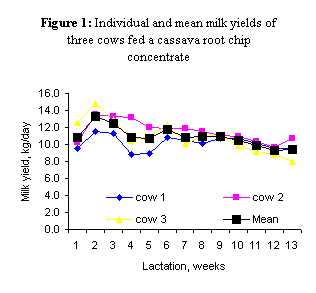| Use of Cassava as Animal Feed |
Feeding cassava chip-based rations to lactating dairy cows
M Wanapat and A Petlum
Department of Animal Science,
Faculty of Agriculture,
Khon Kaen University, Khon Kaen
40002, Thailand
Abstract
A concentrate supplement
containing a high level of cassava root chips (85%) was formulated for feeding
to dairy cows from 1 month before calving and for 13 weeks post-partum. The
high level of cassava chips in the concentrate resulted in a high milk yield and
the milk had a high percentage of fat, lactose and solids-not-fat. The price of
the cassava chip concentrate was 60% lower than a typical commercial product
Key words: Cassava roots, milk, cattle
Introduction
The nature of the carbohydrate source in concentrates is
very important for lactating dairy cows, since it is the main source of energy
for rumen micro-organisms that supply both energy (the volatile fatty acids)
and protein to the animal. Cassava root chips are a rich source of
carbohydrate, with a high fermentation rate in the rumen (Sommart et al 1991;
Nocek and Tamminga 1991). Several studies have been carried out on the effects
of cassava chips replacing from 30 to 50% of the maize meal in lactating dairy
cow rations (Martin et al 1993; Pimpa et al 2000; Sommart et al 2000). Since
cassava chips are widely available in Thailand, and the price is low, their
utilization should be much higher than it actually is, especially by
small-holder dairy farmers. The objective of this experiment therefore was to
demonstrate the potential of a high level of inclusion of cassava chips in the
concentrate used to supplement urea-treated rice straw for lactating dairy cows.
Materials and Methods
Three crossbred Holstein dairy cows were assigned to receive a
concentrate supplement containing 85% cassava chips
(Table1). The concentrate contained 12.1 % crude protein, and was given as a
supplement during one month prior to calving, at the level of 1.5% of live
weight, and at a ratio of 1:2 (concentrate: milk) for three months post-partum. Urea-treated rice straw was fed ad libitum. Milk yield and milk composition were recorded
and samples analyzed for nitrogen, fat, lactose and solids-not-fat using a
Milkco-Scan analyzer.
Results and Discussion
The ingredient and chemical composition of the concentrate
mixture and urea-treated rice straw are presented in Table1.
|
Table 1.
Ingredient and chemical composition of the diet (% in DM except for
the DM content which is “as fed”) |
|||||
|
|
DM |
Ash |
N*6.25 |
NDF |
ADF |
|
Concentrate# |
87.1 |
4.3 |
12.1 |
19.5 |
7.2 |
|
Urea-treated rice straw |
53.7 |
17.5 |
7.6 |
80.5 |
56.6 |
|
# Contains (%): cassava root
chips 85, rice bran 10, urea 3, sulphur 1, mineral mixture 1 |
|||||
It was anticipated
that the large quantities of energy released from cassava chips could be used
together with the urea for rapid microbial protein synthesis. It was observed
throughout the trial that there was no problem with the intake of concentrate,
but an initial adjustment period was necessary. The price of the cassava-based
concentrate was only 2.44 Baht/kg compared to 6.0 Baht/kg for a typical
commercial product.
Milk yield was maintained at a high level throughout the first 13 weeks of lactation (Table 2; Figure 1). The percentages of fat, lactose and solids-not-fat were higher than values commonly reported in lactating cows in the area.
|
|
||||||||||||||||||
Conclusions
- A concentrate based on cassava root chips complemented with urea supported high yields of milk with above average content of fat and lactose in Holstein crossbred cows fed urea-treated rice straw as the source of roughage.
- The price of the concentrate was 60% lower than a typical commercial product.
References
Martins J, Nunes
A F, Andre J L and Vaz Portugal A 1993 Cassava root meal as an energy source for dairy
cattle. In: Animal Production in
Developing Countries. Gill M, Owen E and Lawrence T L (Eds.). Occasional Publication No. 16. British
Society of Animal Production. pp.163-164.
Nocek J E and Tamminga S 1991 Site of digestion of starch in the
gastrointestinal-tract of dairy cows and its effect on milk-yield and
composition. Journal of Dairy Science. 74:3598-3629.
Pimpa O, Sommart K and Wanapat M 2000 Effect
of replacement of ground corn by cassava chip in diets of lactating dairy cows
fed ruzi grass silage. KKU Vet. J. 10; 35-44
Sommart K, Wanapat M, Wachirapakorn C, Chanthai S and Toburan W 1991 Digestibility of organic matter of various energy
sources. In: Proc.Technical Meeting, Kasetsart University, Feb. 4-7, Bangkok.
Sommart K, Wanapat
M, Rowlinson P, Parker D S, Climee P and Panishying S 2000 The use of cassava chips as an energy source for
lactating dairy cows fed with rice straw. Asian-Australasian J. Anim. Sci. 13:
1094-1101.
Wanapat M, Pimpa O, Sommart K, Toburan W, Parker D S and Rowlinson P 1995 Effect of energy sources on ruminal fermentation and straw intake in swamp buffaloes. In Proc. International Workshop on Draft Animal Power (DAP) to Increase Farming Efficiency and Sustainability (Eds: M Wanapat, S Uriyapongson and K.Sommart), Khon Kaen University, Khon Kaen,Thailand.
